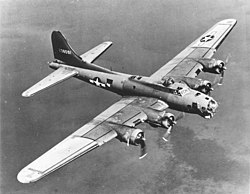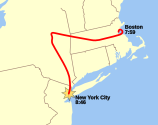Portal:Aviation
| Main page | Categories & Main topics |
|
Tasks and Projects |
The Aviation Portal

Aviation includes the activities surrounding mechanical flight and the aircraft industry. Aircraft includes fixed-wing and rotary-wing types, morphable wings, wing-less lifting bodies, as well as lighter-than-air craft such as hot air balloons and airships.
Aviation began in the 18th century with the development of the hot air balloon, an apparatus capable of atmospheric displacement through buoyancy. Some of the most significant advancements in aviation technology came with the controlled gliding flying of Otto Lilienthal in 1896; then a large step in significance came with the construction of the first powered airplane by the Wright brothers in the early 1900s. Since that time, aviation has been technologically revolutionized by the introduction of the jet which permitted a major form of transport throughout the world. (Full article...)
Selected article
The aircraft crashed into the North Tower of the World Trade Center at 08:46 local time; the impact killed all 92 people aboard, including the hijackers. Many people in the streets witnessed the collision, and Jules Naudet captured the impact on video. News agencies began to report on the incident soon after and speculated that the crash had been an accident. The impact and subsequent fire caused the North Tower to collapse, which resulted in thousands of additional casualties. During the recovery effort at the World Trade Center site, workers recovered and identified dozens of remains from Flight 11 victims, but many other body fragments could not be identified. (Full article...)
Selected image
Did you know
...that in 1943 British Overseas Airways Corporation Flight 777 was shot down by German Junkers Ju 88s, killing actor Leslie Howard and leading to speculation that it was an attempt to assassinate Winston Churchill?

... that before he flew the Spirit of St. Louis on his historic transatlantic flight, Charles Lindbergh's first choice of aircraft was the Ryan M-2?
General images -
In the news
- May 29: Austrian Airlines cancels Moscow-bound flight after Russia refuses a reroute outside Belarusian airspace
- August 8: Passenger flight crashes upon landing at Calicut airport in India
- June 4: Power firm helicopter strikes cables, crashes near Fairfield, California
- January 29: Former basketball player Kobe Bryant dies in helicopter crash, aged 41
- January 13: Iran admits downing Ukrainian jet, cites 'human error'
- January 10: Fire erupts in parking structure at Sola Airport, Norway
- October 27: US announces restrictions on flying to Cuba
- October 3: World War II era plane crashes in Connecticut, US, killing at least seven
- September 10: Nevada prop plane crash near Las Vegas leaves two dead, three injured
- August 6: French inventor Franky Zapata successfully crosses English Channel on jet-powered hoverboard
Related portals
Associated Wikimedia
The following Wikimedia Foundation sister projects provide more on this subject:
-
Commons
Free media repository -
Wikibooks
Free textbooks and manuals -
Wikidata
Free knowledge base -
Wikinews
Free-content news -
Wikiquote
Collection of quotations -
Wikisource
Free-content library -
Wikiversity
Free learning tools -
Wikivoyage
Free travel guide -
Wiktionary
Dictionary and thesaurus
Selected biography
Amy Johnson (1 July 1903 – 5 January 1941) C.B.E. was a pioneering British aviatrix.
Born in Kingston upon Hull, Johnson graduated from University of Sheffield with a Bachelor of Arts in economics. She was introduced to flying as a hobby, gaining a pilot's A Licence No. 1979 on 6 July 1929 at the London Aeroplane Club. In that same year, she became the first British woman to gain a ground engineer's C License.
Johnson achieved worldwide recognition when, in 1930, she became the first woman to fly solo from England to Australia. She left Croydon on 5 May of that year and landed in Darwin, Australia on 24 May after flying 11,000 miles. Her aircraft for this flight, a De Havilland Gipsy Moth (registration G-AAAH) named Jason, can still be seen in the Science Museum in London. She received the Harmon Trophy as well as a CBE in homage to this achievement, and was also honoured with the No. 1 civil pilot's licence under Australia's 1921 Air Navigation Regulations.
In July 1931, Johnson and her co-pilot Jack Humphreys became the first pilots to fly from London to Moscow in one day, completing the 1,760-mile journey in approximately 21 hours. From there, they continued across Siberia and on to Tokyo, setting a record time for flying from England to Japan. The flight was completed in a De Havilland Puss Moth.
Selected Aircraft

The Boeing B-17 Flying Fortress is an American four-engine heavy bomber aircraft developed for the U.S. Army Air Corps (USAAC). Competing against Douglas and Martin for a contract to build 200 planes, the airplane outperformed both the other entries and the Air Corps' expectations. Although losing the contract due to an accident, the Air Corps was so in favor of the B-17 that they ordered 13 B-17s regardless. Evolving through numerous design stages, from B-17A to G, the Flying Fortress is considered the first truly mass-produced large aircraft. From its pre-war inception, the USAAC touted the aircraft as a strategic weapon; it was a high-flying, long-ranging potent bomber capable of defending itself. With the ability to return home despite extensive battle damage, its durability, especially in belly-landings and ditchings, quickly took on mythical proportions.
The B-17 was primarily involved in the daylight precision strategic bombing campaign of World War II against German industrial targets. The United States Eighth Air Force based in England and the Fifteenth Air Force based in Italy complemented the RAF Bomber Command's night-time area bombing in Operation Pointblank, which helped secure air superiority over the cities, factories and battlefields of Western Europe in preparation for Operation Overlord. The B-17 also participated, to a lesser extent, in the War in the Pacific.
Today in Aviation
- 2012 – A Space Shuttle is airborne for the last time as a Shuttle Carrier Aircraft completes a three-day journey to transport the retired Space Shuttle Endeavour from Cape Canaveral, Florida, to Los Angeles, California. After two days of delays due to bad weather, the aircraft had departed Cape Canaveral on 19 September and made low passes over Florida's Space Coast and National Aeronautics and Space Administration (NASA) centers in Mississippi and Louisiana before spending the night at Ellington Field in Houston, Texas; proceeded on 20 September to El Paso, Texas, for a refueling stop before flying over the White Sands Test Facility in New Mexico and over Tucson, Arizona, in tribute to retired Congresswoman Gabrielle Giffords, ending the day with an overnight stop at Edwards Air Force Base in California; and on 21 September had completed the final leg of the journey by making low-level passes over Sacramento, San Francisco, Silicon Valley, and Los Angeles, California, before landing at Los Angeles International Airport.[2]
- 2005 – JetBlue Airways Flight 292, an Airbus A320, makes an emergency landing in Los Angeles, California because of landing gear steering failure. There are no injuries to the 139 passengers and six crew members.
- 2004 – UH-60A Black Hawk 87-24579 from A Company, 1–244th Aviation Regiment crashes near Nasiriyah, wounding four crew members.[3]
- 2002 – Air Canada Douglas DC-9 makes final flight to place of honour at the Canada Aviation Museum
- 1994 – Introduction: Hongdu JL-8
- 1993 – In the first of the three Transair Georgia airliner shootdowns, a Tupolev Tu-134A is hit on approach to Sukhumi-Babusheri Airport by a surface-to-air missile; the plane crashes into the Black Sea, killing all five crew members and all 22 passengers.
- 1984 – First flight of the Dassault Falcon 900
- 1979 – Two RAF Hawker Siddeley Harrier jump-jets from RAF Wittering collide over the UK. Both pilots ejected safely. One of the jets broke up in midair and fell harmlessly into a field but the other dropped onto the center of Wisbech in Cambridgeshire, destroying two houses and a bungalow. Several people were injured in the accident and three people were killed.
- 1969 – The Mexicana Boeing 727-64 XA-SEJ strikes the ground short of the runway on final approach to Mexico City International Airport in Mexico City, Mexico, becomes airborne again, then crashes on a railway embankment, killing 27 of the 118 people on board.
- 1967 – Hawker Siddeley Kestrel, XS693, fitted with 19,000-lb. thrust Bristol-Siddeley Pegasus 6 engine, crashes during trials at Filton, Sqn. Ldr. H. Rigg escaping safely.
- 1964 – First flight of the North American XB-70 Valkyrie, the world’s first Mach 3 bomber in Palmdale, California.
- 1964 – During delivery flight of North American XB-70A-1-NA Valkyrie, 62-0001, from Palmdale, California to Edwards AFB, California, on touchdown the brakes on the main gear lock up and the friction causes the eight tires and wheels to burn. The Valkyrie was otherwise undamaged.
- 1961 – First flight of the Boeing CH-47 Chinook helicopter
- 1956 – Grumman company test pilot Tom Attridge shoots himself down in a Grumman F11F Tiger, BuNo 138260, during a Mach 1.0 20 degree dive from 22,000 feet (6,700 m) to 7,000 feet (2,100 m). He fires two bursts from the fighter's 20 mm cannon during the descent and as he reaches 7,000 feet (2,100 m) the jet is struck multiple times, including one shell that is ingested by the engine, shredding the compressor blades. He limps the airframe back towards the Grumman airfield but comes down at almost the same spot where the first prototype impacted on 19 October: 1954. Pilot gets clear before jet burns, suffers only minor injuries – investigation shows that he had overtaken and passed through his own gunfire.
- 1953 – North Korean pilot No Kum-Sok defects, bringing his MiG-15 with him to Seoul and collecting a $US 100,000 reward.
- 1951 – The US Marine Corps makes the world's first mass combat deployment by helicopter. 228 Marines are landed in 12 Sikorsky HRSs.
- 1943 – (Overnight) A Northwest African Air Force raid on Bastia damages the port enough to slow the German evacuation of Corsica.
- 1942 – First flight of the Boeing B-29 Superfortress
- 1942 – Convoy PQ 18 arrives at Archangel in the Soviet Union. During its voyage, aircraft from the British aircraft carrier HMS Avenger have attacked 16 German submarines and contributed to the sinking of one, and Avenger’s fighters and the convoy’s antiarcraft guns have shot down 41 German aircraft. Because of these high losses, German aircraft rarely attack Arctic convoys again.
- 1939 – First flight of the Lockheed Model 18 Lodestar
- 1938 – USAAC Chief Maj. Gen. Oscar Westover is killed in crash of Northrop A-17AS, 36-349, c/n 289, '1', out of Bolling Field, Washington, D.C., in a crosswind short of the runway at Lockheed Air Terminal in Burbank, California, now known as Bob Hope Airport. The single-engined attack design used as a high-speed staff transport, crashed into a house at 1007 Scott Road in Burbank. Also KWF is his mechanic S/Sgt Samuel Hymes. Northeast Air Base, Massachusetts, renamed Westover Field on 1 December 1939, later Westover AFB on 13 January 1948.
- 1916 – One only prototype Avro 521 fighter, 1811, (a serial that duplicated one assigned to a Bleriot monoplane), assigned to Central Flying School Upavon, crashes killing pilot Lt. W. H. S. Garnett.
- 1913 – The first aerobatic maneuver, a sustained inverted flight, is performed in France.
- 1802 – Frenchman Andre-Jacques Garnerin makes the first parachute descent in England, jumping from a balloon over London.
References
- ^ By Reuters (22 September 2012). "Rebels shoot down fighter jet in northern Syria, witness says - Israel News | Haaretz Daily Newspaper". Haaretz.com. Retrieved 4 October 2012.
{{cite web}}:|author=has generic name (help) - ^ The Associated Press (September 21, 2012). "Anonymous, "'That's my spaceship': Space shuttle Endeavour salutes Gabby Giffords and astronaut husband Mark Kelly in Arizona fly-by". Nydailynews.com. Associated Press. Retrieved December 2, 2012.
- ^ "1987 USAF Serial Numbers". Retrieved 2010-02-17.
- Shortcuts to this page: Portal:Airplanes • P:AVIA




















































